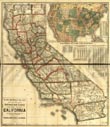What's in a Name?
 I
was recently asked why I named my modules (and my layout for that
matter) with Spanish names. The answer is simply that it matches the
prototype. The railroads predate California statehood, and before we were one of the United States of America, we were Alta California,
a Mexican state. Even before the area was a Mexican territory, it was
home to our Native Americans. From their languages we've got station
names like Mojave (Mile Post 379.5) and Tehachapi (MP 360.5).
I
was recently asked why I named my modules (and my layout for that
matter) with Spanish names. The answer is simply that it matches the
prototype. The railroads predate California statehood, and before we were one of the United States of America, we were Alta California,
a Mexican state. Even before the area was a Mexican territory, it was
home to our Native Americans. From their languages we've got station
names like Mojave (Mile Post 379.5) and Tehachapi (MP 360.5).The Spanish missionaries brought us names like Friar (MP 264.1), and the names of the Saints, such as San Bernardino (MP 81.4). There were also Spanish explorers like Balboa (MP 25.3).
Of course there are as many stations with Spanish surnames as there are white railroad employee surnames. Names like Dominguez (MP 496.2) and Reyes (MP 495.3) are just as common as Edison (MP 320.1) and Smeltzer (MP 519.6).
Some names are Spanglish, a blending of Spanish and English. An example is Buena Park (MP 160.3).
Below is a list of some of the Station names and check points from the area timetables. It is interesting to imagine what they were noticing when they named these places.
- Los Alamitos = The little Aspen trees
- Aliso = Sycamore Trees
- Basta = Enough
- Brea = Oil
- Cajon = Footlocker or chest
- Caliente = Hot
- Casa Blanca = White House
- Corona = Crown
- Esperanza = Hope
- La Mirada = The Lookout
- Oro Grande = Big Gold
- Prado = Grassland
- Rana = Frog
- Redondo = Round (yes, there is a turntable there!)
- El Segundo = The Second (choice?)
- Sierra = Mountains
- Soledad = Solitude


0 comments:
Post a Comment